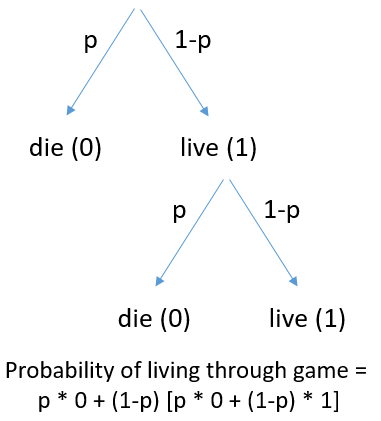Counterintuitive probability problem of the day
 Subscribe to Decision Science News by Email (one email per week, easy unsubscribe)
Subscribe to Decision Science News by Email (one email per week, easy unsubscribe)
TWO SHOT RUSSIAN ROULETTE WITH 2 BULLETS OR AN EQUAL CHANCE OF 1 or 3 BULLETS

With p as the probability of dying on one shot, this figure shows how to get the probability of living through the game.
Peter Ayton is giving a talk today at the London Judgement and Decision Making Seminar
Imagine being obliged to play Russian roulette – twice (if you are lucky enough to survive the first game). Each time you must spin the chambers of a six-chambered revolver before pulling the trigger. However you do have one choice: You can choose to either (a) use a revolver which contains only 2 bullets or (b) blindly pick one of two other revolvers: one revolver contains 3 bullets; the other just 1 bullet. Whichever particular gun you pick you must use every time you play. Surprisingly, option (b) offers a better chance of survival. We discuss a general theorem implying, with some specified caveats, that a system’s probability of surviving repeated ‘demands’ improves as uncertainty concerning the probability of surviving one demand increases. Nonetheless our behavioural experiments confirm the counterintuitive nature of the Russian roulette and other kindred problems: most subjects prefer option (a). We discuss how uncertain probabilities reduce risks for repeated exposure, why people intuitively eschew them and some policy implications for safety regulation.
We can see how many people would think the choice between (a) and (b) doesn’t matter. Naively one might think that 2 bullets leads to the same probability as choosing blindly between 1 and 3 bullets. But this is not true. See the graphic above and plug in different ps.
Or be lazy and let us do it for you. First, approve that this R function is correct:
prob_live_game = function(bullets) {
prob_die = bullets / 6
prob_live = 1 - prob_die
prob_die * 0 + prob_live * (prob_die * 0 + prob_live * 1)
}
Now see below that the probability of living with 2 bullets is .44 while the probability of living with an equal chance of 1 or 3 bullets is .47
> #probability living with 2 bullets
> prob_live_game(2)
[1] 0.4444444
>
> #probability living with 1 bullet
> prob_live_game(1)
[1] 0.6944444
>
> #probability living with 3 bullets
> prob_live_game(3)
[1] 0.25
>
> #probability living with an equal chance of 1 or 3 bullets
> .5 * (prob_live_game(1) + prob_live_game(3))
[1] 0.4722222


This was a fun way of reframing an obvious truth:
2x**2 < (x+y)**2 + (x-y)**2, unless y=0.
Or,
2x**2 < 2x**2 + 2y**2, unless y = 0.
Your example has x = 4 and y = 1.
Thanks.
May 24, 2017 @ 11:11 am
Excuse the shameless plug, but related to this Florian Kutzner (with some others) have reported studies concerning whether people are sensitive to the “advantages” of more uncertain options when they are depending on repeated trials (as in the gun case above). http://pubsonline.informs.org/doi/pdf/10.1287/mnsc.2015.2394
It turns out, in line with the suggestion in the above abstract, that this result is counter-intuitive and people are not generally sensitive to the effect.
Also, cited in the Kutzner et al. paper is an earlier excellent paper by Rode, Cosmides and Toby which makes a related argument and ties it in with the problem of both ambiguity aversion and ambiguity loving.
May 24, 2017 @ 2:10 pm
The problem becomes much more obvious if you consider the choice between a gun with three bullets and the 50/50 chance of getting a gun with 6 bullets or zero bullets. In the first case, the probability of survival is quite low (25% = 50% * 50%). While the probability of survival in the second case is quite high, 50%!
May 25, 2017 @ 2:18 am
Interestingly enough the insight is even more pronounced if you are not allowed to spin the chamber after every trial, i.e. where there is path dependence in choices.
For the two round Russian roulette w/o spinning:
prob_live_game = function(bullets) {
prob_die_1 = bullets / 6
prob_live_1 = 1 – prob_die_1
prob_die_2 = bullets / 5
prob_live_2 = 1 – prob_die_2
prob_die_1 * 0 + prob_live_1 * (prob_die_2 * 0 + prob_live_2 * 1)
}
May 25, 2017 @ 2:48 pm